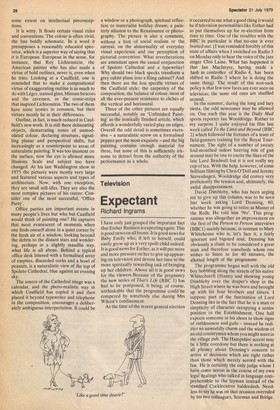Caulfield
John McEwen
Patrick Caulfield, familiar to Spectator readers as the designer of our Christmas covers, has an exhibition of seven new acrylic paintings at Waddington (till 28 July). The place is buzzing. So it should be. A Caulfield show is an event of increasing public interest. At a time when England has more good and varied painters and sculptors than ever before in its history he is unquestionably one of the best. At 43 he has long outgrown his , misleading but convenient classification as a pop artist. Today he is a painter of international stature, too good to be compared only with his contemporaries.
The quality of Caulfield's painting lies in the range of its authority. In this and other ways it is perhaps least inaccurate to classify it as mannerist. It is not mannerist in the fullest Italian sense because it does not insist on the primacy of the human figure — an arm is the most of a human you will see in these latest pictures — but it is based to some extent on intellectual preconceptions.
It is witty. It flouts certain visual rules and conventions. The colour is often vivid, the line boldly schematic. In a word it presupposes a reasonably educated spectator, which is a superior way of saying that it is European. European in the sense, for instance, that Roy Lichtenstein, the American painter who has also made a virtue of bold outlines, never is, even when he tries. Looking at a Caulfield, one is reminded that to make a compositional virtue of exaggerating outline is as much to do with Leger, stained glass, Minoan frescoes and the cavemen, as the comic-strips that inspired Lichtenstein. The two of them have some ironies in common, but their virtues mostly lie in their differences.
Outline, in fact, is much reduced in Caulfield's new work. It is still there delineating objects, demarcating zones of unmodulated colour, declaring structure, signalling planar and perspectival shifts, but increasingly as a counterpoint to areas of naturalistic painting. It was too insistent on the surface, now the eye is allowed more illusions. Scale and subject too have changed. At his last Waddington show in 1975 the pictures were mostly very large and featured various aspects and types of architecture. Now, with one exception, they are small still-lifes. They are also the most complex pictures of his career. Consider one of the most successful, 'Office Party'.
Office parties are important events in many people's lives but who but Caulfield would think of painting one? He captures that most evanescent of moments when one finds oneself alone in a quiet corner by the fresh air of a window, looking beyond the debris to the distant stars and wondering, perhaps in a slightly maudlin way, what life is all about. Behind a typical office desk littered with a formalised array of empties, discarded corks and a bowl of peanuts, is a naturalistic view of the top of Spoleto Cathedral, blue against an evening sky.
The source of the Cathedral image was a calendar, and the photo-realistic way in which Caulfield has copied it and then placed it beyond typewriter and telephone in the composition, encourages a deliberately ambiguous interpretation. It could be a window or a photograph, spiritual reflection or materialist holiday dream, a painterly allusion to the Renaissance or photography. The picture is also a comment, without a hint of social realism or the surreal, on the abnormality of everyday visual experience and our perception of pictorial convention. What reverberations are attendant upon the casual conjunction of Spoleto Cathedral and a typewriter! Why should two black specks transform a grey cubist plane into a filing cabinet? And then there are the less specific virtues of the Caulfield style: the carpentry of the composition, the balance of colour, most of all the ever-present resistance to cliches of the vertical and horizontal.
Three of the other pictures are equally successful, notably an 'Unfinished Painting' as the ironically finished article, which affords a wonderfully varied play on edges. Overall the odd detail is sometimes excessive — a naturalistic screw on a formalised pepper-pot the most exquisite — and the big painting contains enough material for three, but none of this is sufficiently irksome to detract from the authority of the performance as a whole.



































 Previous page
Previous page